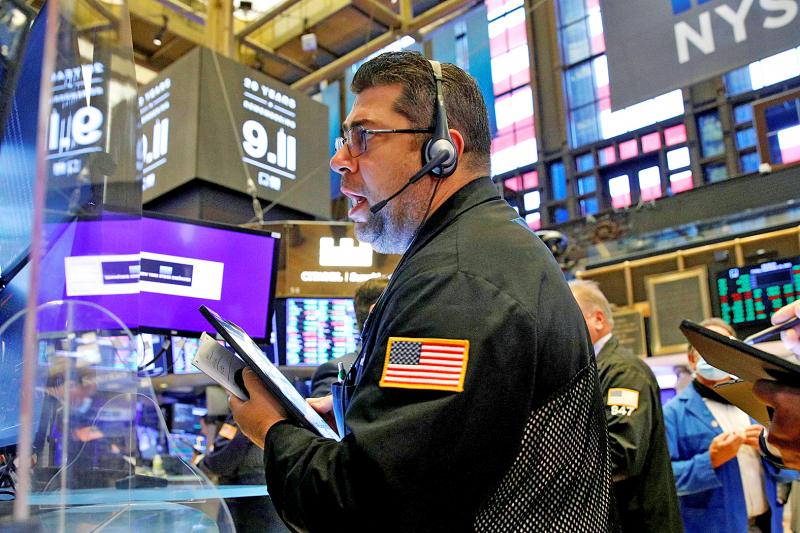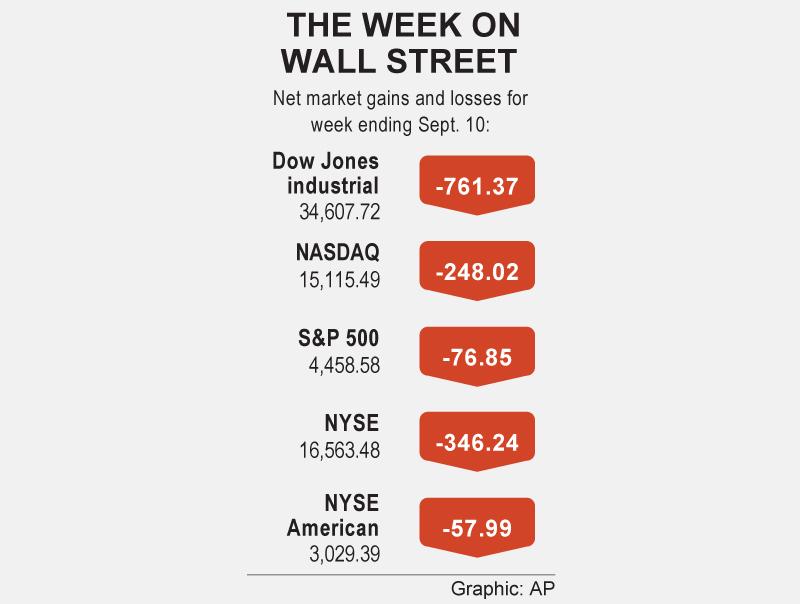Wall Street ended sharply lower on Friday as investors weighed signs of higher inflation, while Apple Inc tumbled following an unfavorable court ruling related to its app store.
US producer prices rose solidly last month, leading to the biggest annual gain in nearly 11 years and indicating that high inflation was likely to persist as the COVID-19 pandemic pressures supply chains, data showed.
Sentiment also took a hit from Cleveland Federal Reserve Bank President Loretta Mester’s comments that she would still like the central bank to begin tapering asset purchases this year, despite last month’s weak jobs report.

Photo: Reuters
The S&P 500 has risen about 19 percent this year, buoyed by support from dovish central bank policies and reopening optimism.
However, Wall Street has moved sideways in the past few sessions as investors digest indications of increased inflation and concerns about effect of the Delta variant of SARS-CoV-2 on economic recovery.
Investors are also uncertain about when the US Federal Reserve might begin reducing massive measures enacted last year to shield the economy from the pandemic.

“The market is taking a breather,” AXS Investments chief executive officer Greg Bassuk said. “Investors are looking for some outsized news or information that is beyond the band of expectations, something much more outsized, positively or negatively, that will give investors better visibility into how things are going to look for the balance of the year.”
Apple dropped 3.3 percent after a judge struck down a core part of its App Store rules, benefiting app makers. Its drop contributed more than any other stocks to the NASDAQ and S&P 500’s declines.
Shares of app makers rallied, with Spotify Technology SA up 0.7 percent, and Activision Blizzard Inc and Electronic Arts Inc gaining about 2 percent.
Losses in the three main indices accelerated toward the end of the session. The Dow Jones Industrial Average fell 0.78 percent to close at 34,607.72 points, while the S&P 500 lost 0.77 percent to 4,458.58. The NASDAQ Composite dropped 0.87 percent to 15,115.49.
For the week, the S&P 500 lost 1.69 percent, the Dow declined 2.15 percent and the NASDAQ shed 1.61 percent.
Friday was the first time since February that the S&P 500 had dropped for five days in a row.
The three main US indices received some early support from news of a telephone conversation between US President Joe Biden and Chinese President Xi Jinping (習近平), which could bring a thaw in ties between the world’s two most important trading partners.
All of the 11 S&P 500 sector indices fell, with real estate and utilities each down more than 1 percent and leading the declines.
Volume on US exchanges was 10.0 billion shares, compared with the 9.2 billion average for the full session over the past 20 trading days.
Declining issues outnumbered advancing ones on the NYSE by a 1.84-to-1 ratio, while on the NASDAQ, a 1.88-to-1 ratio favored decliners.
The S&P 500 posted 15 new 52-week highs and three new lows; the NASDAQ Composite recorded 55 new highs and 47 new lows.

The US dollar was trading at NT$29.7 at 10am today on the Taipei Foreign Exchange, as the New Taiwan dollar gained NT$1.364 from the previous close last week. The NT dollar continued to rise today, after surging 3.07 percent on Friday. After opening at NT$30.91, the NT dollar gained more than NT$1 in just 15 minutes, briefly passing the NT$30 mark. Before the US Department of the Treasury's semi-annual currency report came out, expectations that the NT dollar would keep rising were already building. The NT dollar on Friday closed at NT$31.064, up by NT$0.953 — a 3.07 percent single-day gain. Today,

‘SHORT TERM’: The local currency would likely remain strong in the near term, driven by anticipated US trade pressure, capital inflows and expectations of a US Fed rate cut The US dollar is expected to fall below NT$30 in the near term, as traders anticipate increased pressure from Washington for Taiwan to allow the New Taiwan dollar to appreciate, Cathay United Bank (國泰世華銀行) chief economist Lin Chi-chao (林啟超) said. Following a sharp drop in the greenback against the NT dollar on Friday, Lin told the Central News Agency that the local currency is likely to remain strong in the short term, driven in part by market psychology surrounding anticipated US policy pressure. On Friday, the US dollar fell NT$0.953, or 3.07 percent, closing at NT$31.064 — its lowest level since Jan.

The New Taiwan dollar and Taiwanese stocks surged on signs that trade tensions between the world’s top two economies might start easing and as US tech earnings boosted the outlook of the nation’s semiconductor exports. The NT dollar strengthened as much as 3.8 percent versus the US dollar to 30.815, the biggest intraday gain since January 2011, closing at NT$31.064. The benchmark TAIEX jumped 2.73 percent to outperform the region’s equity gauges. Outlook for global trade improved after China said it is assessing possible trade talks with the US, providing a boost for the nation’s currency and shares. As the NT dollar

The Financial Supervisory Commission (FSC) yesterday met with some of the nation’s largest insurance companies as a skyrocketing New Taiwan dollar piles pressure on their hundreds of billions of dollars in US bond investments. The commission has asked some life insurance firms, among the biggest Asian holders of US debt, to discuss how the rapidly strengthening NT dollar has impacted their operations, people familiar with the matter said. The meeting took place as the NT dollar jumped as much as 5 percent yesterday, its biggest intraday gain in more than three decades. The local currency surged as exporters rushed to